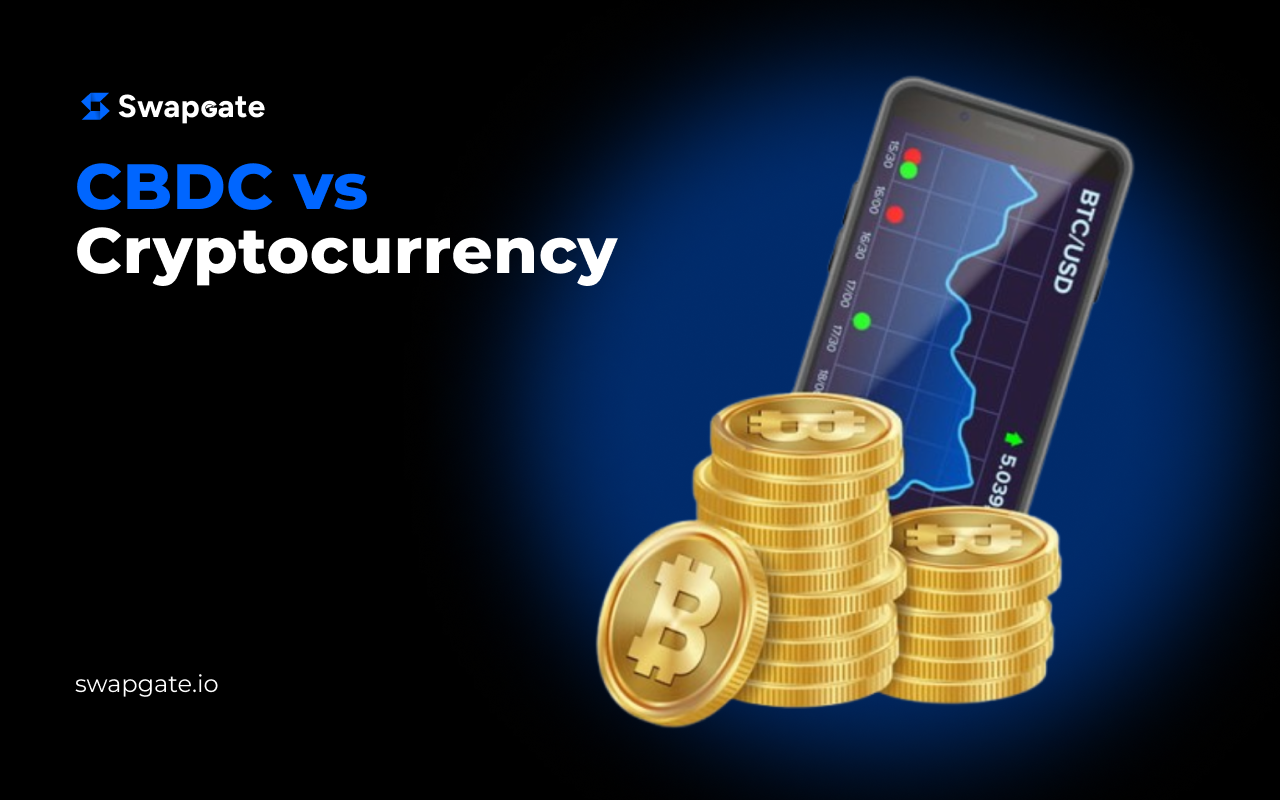
Digital finance is growing rapidly, and it seems that soon it may overshadow traditional systems. Two dominant areas in recent years are cryptocurrencies and Central Bank Digital Currencies (CBDC). In 2024, both have a massive impact on global financial markets, sparking numerous discussions about their future. While CBDCs and cryptocurrencies may seem similar, they have significant differences that define their potential and role in the world economy. This article explores what CBDC and cryptocurrency are, their key differences, and the opportunities they present to users.
What are CBDC and Cryptocurrency: Similarities and Differences
Central Bank Digital Currencies (CBDCs) are digital equivalents of traditional currencies, issued and controlled by central banks. Their primary goal is to create a modern, secure, and efficient payment system. CBDCs can exist both as digital and cash forms, making them accessible to a wide range of users.
CBDCs aim to solve several issues traditional money systems face. They can reduce operational costs, such as printing and processing cash, speed up cross-border payments, and improve transaction transparency. However, the main difference from cryptocurrencies is that CBDCs are fully controlled and regulated by the government, which significantly affects their use and security.
Cryptocurrency is a decentralized digital asset based on blockchain technology, functioning without the involvement of governmental or central bank authorities. Examples include Bitcoin, Ethereum, and many others. These assets allow users to conduct transactions anonymously and hold assets without intermediaries, such as banks.
Cryptocurrencies’ key feature is their independence from the government and inflation. Users control their own funds, and all transactions are secured through cryptography. In 2024, cryptocurrencies play a crucial role in fintech innovations, offering decentralized financial services (DeFi) such as staking and farming, which allow users to earn passive income.
Overall, CBDC and cryptocurrency share many features but also have distinct differences. Both digital asset categories have their place in an investment portfolio.
CBDC and Cryptocurrency: Key Differences
- Centralization vs. Decentralization: CBDCs are fully controlled by the state, making them dependent on monetary policies and regulatory bodies. Cryptocurrencies, in contrast, are decentralized and operate independently of authorities.
- Regulation and Security: CBDCs are backed by central banks, ensuring stability against currency fluctuations. They are also regulated by law and protected by governmental institutions. Cryptocurrencies, however, are highly volatile and dependent on market demand and supply. But they offer more privacy and independence for users.
- Transaction Transparency: CBDC transactions are fully tracked and monitored by the government, making them less appealing for those seeking anonymity. Cryptocurrencies, depending on their type, can offer partial or full anonymity in transactions.
- Fintech Innovations: Cryptocurrencies are already being actively used in innovative solutions like DeFi and smart contracts. CBDCs, though created to improve traditional financial systems, offer fewer decentralized opportunities for users.
Advantages and Disadvantages of CBDCs
CBDCs have several advantages. First, they can improve monetary control and reduce fraud, as every transaction is registered and tracked. Second, they accelerate payment processes, especially in cross-border operations. Third, CBDCs could help manage inflation, as central banks can regulate the money supply in digital format.
However, there are also challenges. The main concern is privacy: users may fear total government control over their funds and transactions. Additionally, CBDC implementation requires massive infrastructure changes and international cooperation to resolve regulatory and security issues.
Advantages and Disadvantages of Cryptocurrencies
Cryptocurrencies offer many opportunities, particularly in decentralized finance. Staking and farming allow users to generate passive income, while blockchain technology enables secure and anonymous transactions. The absence of intermediaries makes cryptocurrency appealing to users who value independence from banking systems.
However, cryptocurrencies face challenges. The high market volatility makes them risky assets for investors. Furthermore, despite cryptographic protection, regulation remains an issue. Many countries are still actively debating the legality and control of cryptocurrencies, though, for example, the 2024 U.S. presidential race showed that the world’s leading economy is ready to support cryptocurrency.
What Does the Future Hold?
As of today, both approaches — CBDCs and cryptocurrencies — have great potential. Many experts predict that governments will actively develop their CBDCs, integrating them into everyday payment systems. This could help improve financial infrastructure and provide greater control over economic processes. However, such measures may strengthen centralized control, raising concerns about users’ privacy and independence.
At the same time, cryptocurrencies will continue to evolve as an essential part of fintech. Their decentralization and independence from government institutions make them attractive to investors and users, especially in the realm of DeFi. In the future, we can expect further development of hybrid solutions that combine the benefits of both decentralized cryptocurrencies and state-backed digital currencies.
Conclusion
The development of digital currencies, including CBDC and cryptocurrency, will significantly impact the future of the financial system. CBDCs provide stability and security, offering users legalized and regulated assets, while cryptocurrencies continue to offer independence and anonymity.
The future will show whether these two forms of currency can coexist or if one will take the dominant position. Either way, the growth of fintech will continue to open new horizons for financial technologies.